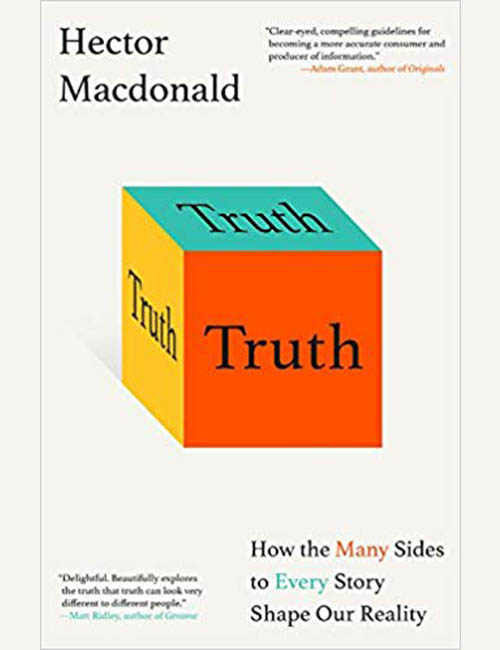Reviewed by Susan Fader, susanfader@faderfocus.com
Fader & Associates, Teaneck, NJ
Psychologists Daniel Simons and Christopher Chabris conducted a famous study where people were asked to watch a video and count how many times the people wearing white pass the basketball. During the middle of the video, a person dressed in a gorilla suit walked onto the court. At the end of the video nearly everyone could tell you how many passes were thrown, but most did not remember seeing a gorilla. “Selective attention” caused them to not see something that was literally right in front of them. When we observe and process information we selectively focus, and we only “see” some of the facts/what’s happening. By doing so we create a reality that is based on selective information. In other words, one’s reality is based on the facts one chooses to focus on while ignoring other facts that may create a different reality.
Hector Macdonald’s masterful book, Truth: How the Many Sides to Every Story Shape Our Reality, uses a myriad of storytelling examples to present a fascinating analysis of how we use selective facts to create stories that support our objectives, while providing storytelling guidelines for anyone who wants to become a better storyteller. He also provides us with insight into how to better listen, react to and question stories that we are told, so that we are less likely to be misled by a story. Macdonald, an expert in business storytelling, has spent over a decade writing stories for companies and government organizations and his examples of business stories that achieve different goals are very helpful.
Truth, for Macdonald, is like a bowl full of spaghetti where we pick the few strands to tell our story. We build our story around only these few strands, because picking more would make the information too overwhelming to process, and he feels this selection process is “the price we pay for clarity and coherence.” I found his many examples of taking an event and then selecting different strands of spaghetti to create different stories that sometimes appeared to support opposite conclusions to be extremely insightful. I like his four quinoa stories that show how each story can bring the listener to arrive at dramatically different conclusions. This wide spectrum of conclusions range from everyone outside of Peru should stop buying and eating quinoa because increased demand has made the quinoa prices for Peruvians skyrocket, to you should eat more quinoa because the increased consumption and exports of quinoa have dramatically improved the living standards for Peruvian quinoa farmers.
While we currently live in an Alice Through the Looking Glass world where lies are sometimes spun as truths, Macdonald’s book is focused on building stories around truthful pieces of information and not lies. He identifies three different type of communicators and shows how each uses stories to achieve their goals, with the objective being that we should all try to be Advocates when creating and telling stories:
- Advocates – “selecting competing truths that create a reasonably accurate impression of reality in order to achieve a constructive goal.”
- Misinformers – “innocently propagating competing truths that unintentionally
distort reality.” - Misleaders – “deliberately deploying competing truths to create an impression of reality that they know is not true.”
For Macdonald, a successful story has three components: a process of change, casual relationships, and a trigger. He deconstructs famous stories (e.g., Hamlet and The Wizard of Oz) to stress this, while at the same time creating new stories to show the reader how to construct around the three central themes.
Truth: How the Many Sides to Every Story Shape Our Reality is a very enjoyable and informative read. It provides the reader with guidelines to evaluate the stories we hear, while at the same time providing new perspectives on how to use truth to create impactful stories. He provides a different perspective on storytelling from other books on storytelling that I have read, and his analysis of what makes a truthful story is definitely a book for our times.


Be the first to comment